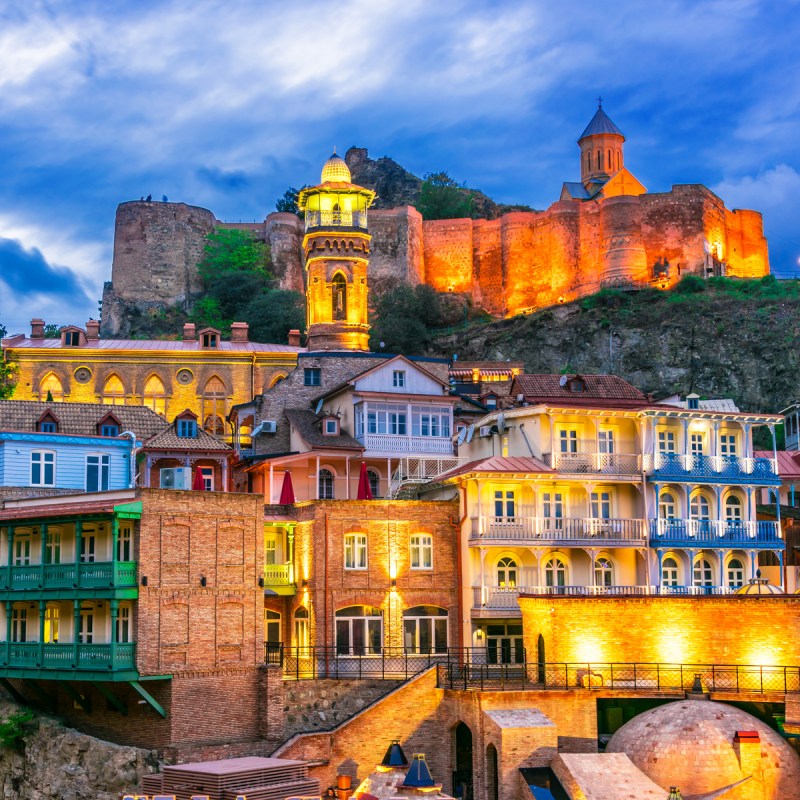
Tbilisi is the capital of the country of Georgia, on the intersection between Europe and Asia, nestled between the Black Sea and the Caspian Sea, bordered by Russia in the north, Azerbaijan in the east, and Turkey and Armenia in the south. Famous for its mountainous location, with the Caucasus Mountains dominating the landscape, Georgia is well-known for its wine, its rich cultural heritage, and its national pride, which — despite having been annexed, incorporated, and dominated by other nations on and off over centuries — has never been broken.
Videos by TravelAwaits
Tbilisi, in the southeast of the country, is the colorful capital of this multifaceted nation, full of history and tradition, and brimming with sights to see, yet nearly devoid of tourists. This might well be due to a certain amount of difficulty reaching Tbilisi from afar. From the U.S., you will have to change flights in Frankfurt, Germany, or Istanbul, Turkey, for the quickest connections. But also, the region is misunderstood abroad, and people are afraid to visit. This should not be so. Georgia is safe and the Georgian people could not be more welcoming.
It was love at first sight visiting Tbilisi: the city is a superb mix of ancient history and modern life, an architectural range covering everything from a fortress dating to the 4th century to medieval sulfur baths and hyper-modern examples. There are countless small streets to meander through, the love for coffee, wine, and food is evident everywhere, there is art, and there is natural beauty. Basically, I could not understand why I had never visited before.
So, here I will give you some very good reasons to book that flight and visit Tbilisi.

The Georgian People
Let’s start with a country’s greatest asset: its people. I did not meet one grumpy or scary person, everybody seemed accommodating, helpful, and happy to see me, a rare tourist. But what convinced me beyond a doubt that these people are good people, were the street dogs. That might sound weird to you, but wherever you go in Tbilisi, there are these enormous dogs living on the streets. Most have tags in their ear, meaning they have been vaccinated, and every single one is friendly and wants to be pet. And wherever they decide to rest, they are allowed to do just that: there was a huge furry lump right in the middle of the airport, fast asleep and people just stepped past him. In the entrance of restaurants, if a dog sleeps, he sleeps, and in the middle of the pavement? No problem, at all. All well fed, all friendly, all more than tolerated. Not one dog seemed unhappy or unfriendly because they are treated as part of the city’s tapestry. And, if people are like that toward dogs, you can’t really go wrong.

The Silk Road Connection
The fabulous Silk Roads, those historic trade routes that connected China to the Mediterranean Sea, carrying, as the name suggests, mostly silks, but also other valuable trade between 100 B.C. and around the mid-1400s with routes going through Georgia and Tbilisi. Connecting the major cities of Istanbul and Baku, Tbilisi might have been a lesser center, but nevertheless, it was part of these fabled routes. My personal ambition is to travel along the Silk Roads, and I am working on connecting the dots, so this was a big reason for me to see Tbilisi’s part of it. There is a Silk Museum here, a few old Caravanserais, one turned into the interesting Tbilisi History Museum, and the famous hot springs which have soothed many a weary traveler’s aches and pains.

The Hot Springs
The name Tbilisi means warm place, referring to the city’s many hot sulfur springs. According to legend, King Vakhtang Gorgasali, whose statue stands looking out over the river Mtkvari in Tbilisi, stumbled upon some hot springs in the countryside in the 5th century and built Tbilisi around them. In their heyday, around the 1200s, there were reportedly some 60 bathhouses in the city. Today, only a dozen or so remain. These all stand in the old part, pretty much exactly opposite King Vakhtang Gorgasali’s statue, some with medieval brick domes, and the prettiest, and most popular on Instagram. The Chreli-Abano bathhouse looks like an Iranian mosque with the façade covered in turquoise tiles. Next to this bathhouse, a gorge has been formed by the water trickling along, discoloring the rocks — adding a whiff, not a stink — of sulfur to the air.

The Georgian Food
When you first step into a souvenir shop, you’ll be wondering what all these funny motifs are on socks, on fridge magnets, as salt and pepper shakers — anything, really. Looking a little like garlic bulbs, they are in fact Khinkali, the local dumplings. But there are also depictions of Khachapuri, a bread formed into a bowl and filled with cheese and an egg that cooks in the hot cheese. As for the strange things hanging from stalls, they look like, according to my husband, candles, and according to me, lumpy salamis. Instead, they are Churchkhela, nuts soaked in grape juice, strung up on cord, and covered in a waxy grape residue. Food is everywhere, and national pride in the somewhat peculiar dishes is high. Forget the diet and just enjoy.

The Superb Architecture
I am always looking up at buildings, old and new — which is one of the reasons I sprained my ankle in Tbilisi. Looking up and medieval paving stones do not go well together. Still, it is worth looking up and around in this city: from the improbable charming residential houses with gorgeous intricate balconies, to the ancient hot spring baths and the grand buildings along Rustaveli Avenue. You can also see hyper-modern structures such as the Bridge of Peace and the mushroom-like House of Justice to the Music Hall, which looks like two rolled sheets of steel. It all sits together harmoniously and works well together. A great city for architecture enthusiasts.

The Chance To Celebrate Christmas Twice
You know how you feel when Christmas is drawing to a close, and you don’t want it to end? Well, if you visit Tbilisi after your Christmas has finished, you can celebrate it again. In Georgia, Christmas is celebrated on January 7, according to the Orthodox traditions. That does not mean locals don’t decorate before the Christian Christmas dates. In fact, the lights along Rustaveli Avenue switch in mid-December and look truly stunning. The Freedom Square is also decked out in countless lights, and a Christmas market sells traditional handicrafts, and mulled wine. Glintwein, as it is called there, is sold outside the Parliament Building on Rustaveli Avenue. So, it’s win, win if you like Christmas.

The Markets
Every city has its markets, and they always provide a great insight into local life. Be it finding out what produce is grown locally, snacking on street food, or having a look at art, and arts and crafts produced in the city, I love a good market. Here, there are a few to keep you busy, such as the Dry Bridge Market, which runs every day all day long and offers an eclectic mix of old Soviet memorabilia, flea market knick-knacks, art, and everything in between. There is the Meidan Bazaar underground in the old town, selling everything you might want to take home as a souvenir — from honey and wine to socks decorated with the Khinkali dumplings. Wood carvings and paintings, jewelry, and pottery are all sold in a great setting. And then, you have the fruit stalls that are set up at every corner, selling seasonal goodies, such as pomegranates, which get pressed into fresh juice there and then.
It Is Cheap
Once you are in Georgia, it is very cheap to eat, drink, and have fun, spending only a few Georgian Lari (GEL). An average coffee is around GEL5 ($1.50) in a trendy little coffee shop; a substantially sized Khachapuri with cheese is around GEL3 ($1), a Khinkali dumpling GEL1.50 ($0.50), and a glass of local wine GEL7 ($2.50), with a bottle coming in at around GEL20 ($6.50). Admission to museums is around GEL15 ($4.80), a bus or metro trip sets you back GEL0.50 ($0.15) and an open top bus 24-hour sightseeing ticket is around GEL60 ($15).

Gateway To Georgia
And let’s not forget the rest of Georgia. This is one beautiful country full of mountains, meadows, and forests, all interspersed with traditional little villages and churches on mountaintops. And then there is, of course, the Black Sea. It is a long way to come for Tbilisi alone, although the city is eminently worth it. I would suggest flying into Tbilisi, staying a while, and then going and exploring the rest of the country. Must-sees are places such as the modern metropolis of Batumi on the Black Sea coast, the traditional Svaneti region, and not to forget the various wine regions, such as Kakheti and Kartli. You can tour Kakheti from Tbilisi as well on a day trip.
Pro Tip: The Georgian scripts are three different writing systems, making up one of the most unique and beautiful-looking alphabets in the world. While learning it won’t help you much, try at least to add a few phrases to your repertoire. Most tourism-related people speak some English, but many others do not.
Other destinations to consider near Georgia include:
